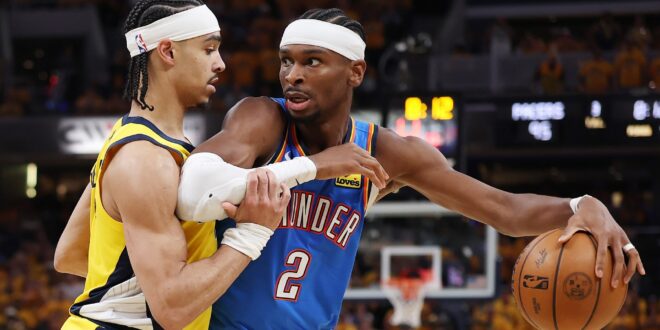OKLAHOMA CITY — The NBA Finals have reached their climactic Game 7, with 48 minutes (or perhaps a bit more) set to decide whether the Indiana Pacers or the Oklahoma City Thunder will capture their inaugural NBA championship.
Should the Thunder emerge victorious, they will statistically be regarded as one of the greatest champions in the history of the NBA. Conversely, a win for the Pacers would position them as one of the most surprising teams ever to hoist the Larry O’Brien Trophy.
Here are seven key statistics to consider ahead of Game 7, scheduled for Sunday at 8 PM ET on ABC…
Historically, home teams boast a record of 15 wins to 4 losses in Game 7 of the Finals, although the most recent instance (in 2016) saw the visiting team claim victory. Excluding three Game 7s played in the 2020 bubble, road teams have won 14 out of the last 26 playoff Game 7s.
This statistic includes a noteworthy 21-point triumph for the Pacers in last year’s Eastern Conference semifinals, where they achieved a playoff-record shooting percentage of 67.1% at Madison Square Garden.
In this year’s Western Conference semifinals, the Thunder won their Game 7 by 32 points, limiting the Denver Nuggets to a mere 93 points across 101 possessions.
Six players involved in the series have experience in previous Game 7 encounters…
If you believe that Finals Game 7s tend to be more chaotic compared to the preceding games in the series, you’re correct.
With access to play-by-play data, we observe that in the four Finals Game 7s, teams have typically scored an average of 6.7 points less per 100 possessions compared to the first six games of the series. The pace has also slowed, with an average of 2.4 fewer possessions (per team) over a 48-minute period.
In terms of pace and efficiency for Finals Game 7 compared to the first six games of the series:
– Offensive Rating (OffRtg): Points scored per 100 possessions
– Pace: Number of possessions (per team) per 48 minutes
Slower gameplay and decreased efficiency lead to a higher likelihood of close games. Notably, the last eight Finals Game 7s have all been decided by single-digit margins.
Both the Thunder and Pacers have recorded an average of 110.0 points per 100 possessions and 99.8 possessions (per team) over the first six games, suggesting that Game 7 may produce a scoring rate closer to one point per possession.
The Pacers have emerged as victors in the two lowest-scoring games of the Finals: Game 1 (with a combined offensive rating of 107.8 per 100) and Game 6 (at 98.5). However, they have a playoff record of 2-6 (2-2 in this series) when scoring under 110 points per 100 possessions.
In contrast, the Thunder have a record of 1-6 when failing to score at least 110 points per 100 possessions, with their sole victory being Game 4 in Denver. Six out of these seven games occurred on the road, the exception being their Game 1 in the Finals.
In their three Finals victories, the Thunder have outscored their opponents significantly, posting 120.4 points per 100 possessions compared to just 101.0 in their three losses. This disparity reflects a stronger performance on the defensive end than the Pacers’ offensive output (110.6 to 108.5 per 100).
“Our defense has been more consistent in these playoffs, particularly,” remarked Thunder coach Mark Daigneault on Saturday, “than our offense.”
In a league defined by shooting ability, three role players for the Thunder—Alex Caruso, Aaron Wiggins, and Cason Wallace—have demonstrated significantly better shooting in the three wins (with a combined effective field goal percentage of 59.8%) compared to the three losses (39.0%).
However, these players have not taken many shots, and the overall difference in the Thunder’s effective field goal percentage from wins (52.2%) to losses (48.4%) is not drastic. Also notable is a reduced turnover rate (13.9 vs. 15.4 per 100 possessions), an increased free throw rate (40.6 vs. 31.9 attempts per 100 field goal attempts), and a higher offensive rebounding percentage (36.4% vs. 24.3%).
Interestingly, the Thunder have taken just 32.9% of their attempts from beyond the arc, the lowest percentage of any team in any playoff series, a marked decrease from their previous rate of 40.6% during the first three rounds. Over these six games, they have been outscored by 54 points from three-point territory.
The most significant decline has been observed in their catch-and-shoot opportunities, dropping from an average of 28.5 attempts per game (ranking third among playoff teams) to just 20.2 attempts per game in the Finals.
Throughout the six games, the Pacers have completed 705 more passes than the Thunder, based on data from Second Spectrum tracking.
A significant factor behind the Thunder’s reduction in catch-and-shoot attempts is a substantial decline in ball movement from the previous rounds. They have made 65 fewer passes per 24 minutes of possession compared to earlier in the playoffs.
On the other hand, the Pacers have improved their ball movement relative to their performance in the conference finals, where they ranked second for ball movement, just behind the Golden State Warriors.
In terms of passes per 24 minutes of possession, comparing the Finals to the prior three rounds:
– TOP: Duration of possession
– Pass/24: Passes made per 24 minutes of possession
Gilgeous-Alexander and Jalen Williams have both decreased the rate at which they pass during drives, dropping from 39% in the early rounds to 29%. They have accumulated more turnovers (13) than assists (10) in those scenarios.
In their last four games, the Thunder have collectively registered 65 assists against 67 turnovers. Their three games in Indiana (Games 3, 4, and 6) coincided with their lowest assist-to-turnover ratios of the season, which spans 104 games.
Despite enjoying a significantly higher free throw rate in their victories compared to losses, the Thunder have still outscored the Pacers from the foul line in all six games, totaling a 35-point advantage (154-119). In fact, the Pacers have been bested in free throw scoring in 14 of their last 16 games.
This trend is more reflective of their defensive struggles than offensive issues, as their opponents have an average free throw rate of 33.6 attempts per 100 field goal attempts, marking the highest such statistic for any team reaching beyond the first playoff round in the last decade.
Among 96 players who have participated for at least 150 minutes in this postseason, Thomas Bryant (5.4), Nesmith (5.2), and Ben Sheppard (4.7) rank first, second, and fifth in fouls per 36 minutes played.
Andrew Nembhard has defended Gilgeous-Alexander for 51 minutes and 29 seconds over the six games, which is 18:31 longer than any other player has defended an opponent in this series (the next closest is Dort, who defended Haliburton for 32:58).
This matchup is critical for both teams in the series and is likely to remain so in Game 7. Nevertheless, according to Second Spectrum…
All eyes will be on the series MVP this Sunday, and it’s the Thunder’s offensive performance that has influenced the outcomes of Games 1 through 6. However, any shift in performance on either side of the court could sway Game 7, and ultimately, the championship.
* * *
John Schuhmann is a senior stats analyst for NBA.com. You can reach him via email, view his archives, and follow him on X.
The opinions expressed herein do not necessarily reflect those of the NBA, its teams, or Warner Bros. Discovery.
 NBA News NBA News, Match Reports and Updates
NBA News NBA News, Match Reports and Updates



